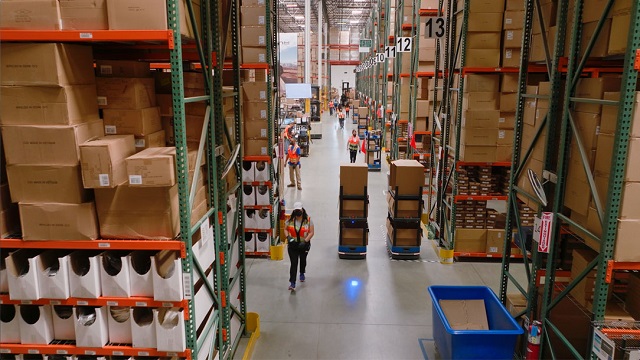Over half of a picker’s time is spent walking from one bin or storage area to the next. Wave picking and batch picking are two order picking methodologies that aim to reduce time spent walking either by eliminating repeated trips to the same location or creating a more efficient route. Both methods save time and speed up warehouse operations, but which way is better for you?
Definition of wave picking

In wave picking, one picker picks a single order and goes after one SKU at a time. Orders are grouped into waves which match shipping goals and schedules. Waves are scheduled throughout the day, depending on picking needs.
Wave picking comes in two flavors: fixed wave picking and dynamic wave picking. In fixed wave picking, orders are held back from packing until all the items from the wave have been picked. With dynamic wave picking, orders are sent to the packers as soon as they’re completed.
Both methods work well in specific scenarios, but dynamic wave picking isn’t ideal if you have a high volume of orders. You end up with extra employees to watch for completed orders, and your sorters’ time isn’t always used efficiently. They tend to end up waiting on completed orders to get moved out of the way unless you employ an army of people to watch the sorting line for completed orders.
Advantages of wave picking
Wave picking is a popular picking methodology, and for good reason. It offers a few important advantages that make it particularly useful for some picking scenarios. Wave picking allows warehouse managers to schedule picking windows at specific times throughout the day, allowing them to schedule picking when it’s least likely to interfere with other processes on the warehouse floor. By scheduling specific picking windows, managers are better able to coordinate picking and shipping processes.
Waves can be grouped based on different criteria such as order lines, and functions such as case picking or pallet movement, so managers can easily estimate labor requirements to reduce overhead and minimize labor costs.
Now, let’s take a closer look at batch picking to compare the two picking methods.
Definition of batch picking

In batch picking, a single picker picks a batch of orders, which helps reduce repeated trips to the same location. An order management system (OMS) analyzes each batch of orders and helps pickers determine the most efficient route to pick each item. The goal is reducing the number of times a picker must visit the same bin to fulfill an order.
When all the steps a picker needs to take are organized, the picker works more efficiently and fulfills orders faster. The logic is simple, and this method works best if you commonly have multiple orders that require the same product. As with wave picking, a picker goes after one SKU at a time.
Batch picking is most often used when orders have fewer than four SKUs and each item is small. Large or bulky items might require additional resources or tools to pick or a more robust picking system using some type of automation capable of handling heavy loads.
Advantages of batch picking
Like wave picking, batch picking offers a few advantages. The primary benefit is that it requires the picker to visit each pick location only once while filling several orders. Eliminating repetitive trips coupled with optimized picking routes (determined by the OMS) reduces travel time, making pickers more productive and lowering labor costs.
One important distinction between wave picking and batch picking is that batch picking requires just one order picking window per shift. In contrast, wave picking may include multiple waves per shift.
Which is better?
Wave picking is better when batch picking isn’t ideal, and the reverse is true as well. In other words, no method is truly better. Choosing the right picking methodology, however, is key to overall warehouse productivity. So how do you determine which method is right for you?
If you stock small items, batch picking may be your best option since multiple items will fit on a cart or trolley. Pickers will spend less time traveling to and from each zone since they can grab numerous items for several orders at one time. If productivity is low and your pickers are wearing out shoes, batch picking can increase efficiency and reduce trips to the same bin.
Wave picking is probably the best option if you deal with a lot of different items of varying sizes. Wave picking may require more employees, which can create congestion in the warehouse, but a good OMS can eliminate many traffic jams.
The final decision comes down to your picking needs and the type of items you deal with regularly. Wave picking is superior if you deal with a large variety of items and high-volume picking and packing. For low-volume scenarios where rapid order fulfillment isn’t a top priority and the pick items are small and less varied, batch picking will probably outperform wave picking.
Warehouse managers should determine the ideal picking methodology based on the warehouse’s needs, items per order, item sizes and other factors. We urge you to consider all the factors and test the method that’s best suited for your inventory and the volume of orders you need to fill each day.
For more on wave picking, check out our post on Zone Picking vs Wave Picking: Which is Best?


